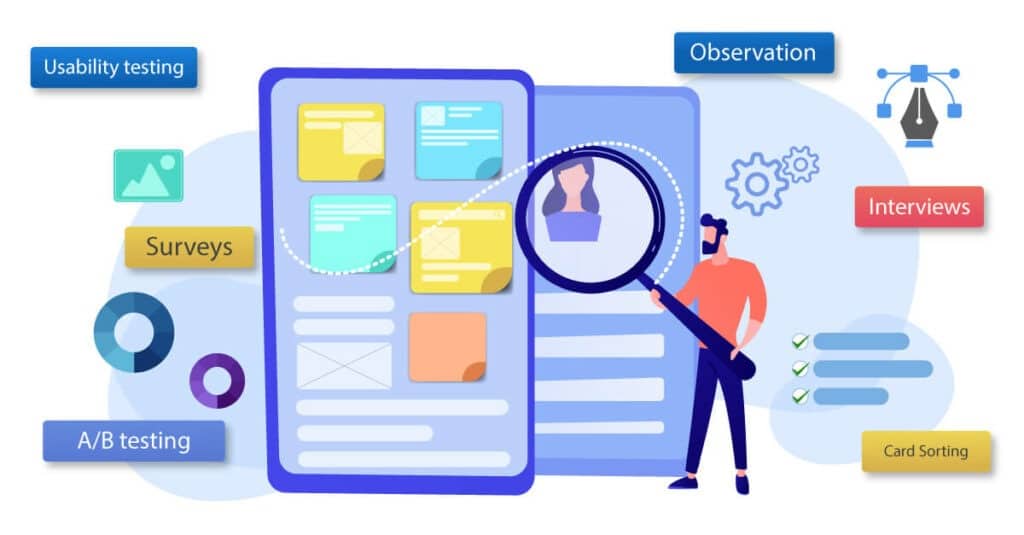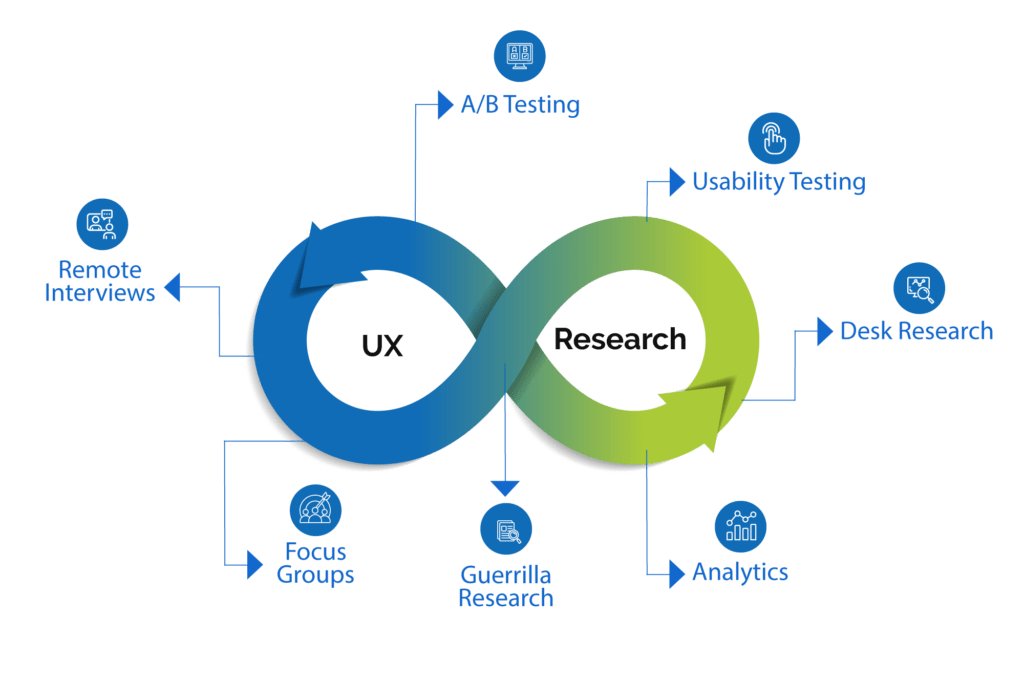How to Conduct User Research for UI/UX Development: Methods and Tools
User research is an inevitable part of User Experience Design. It is a process of understanding users’ needs, behaviors & motivations through various methods like surveys, interviews, observations, & usability testing.
Are users enjoying the experience with the brand? Do they need help with heavy theory content, several messages & pop-ups? Are they willing to purchase something or look for inspiration on your web or app? Are they feeling engaged and like your brand? Or they like your product but turn around to your competitors because of the poor user experience you provide.
Usually, stakeholders and UI/UX designers have a motive behind conducting user research & that is, to have a thorough understanding of users, which can be used to design better apps or websites. During the research, stakeholders will come to terms with observing your target users and understanding their needs, behaviors & pain points considering the product or service you’re designing.
Ultimately, the difference between designing based on guesswork and conjecture, & actually designing something that deciphers a real user problem.

Why is User Research Important?
User research is fundamental to building products that are centered around people. It helps with finding out the exact want of the users and delivering significant products and experiences that users will enfold. User Research is essential because it helps designers and product teams create genuinely user-centered products.
User research helps you to design great products!
There is generally a misbelief that it’s okay to do some research and that user testing can be done at the end. But instead, you should do the UX research first, followed by usability testing and iteration throughout.
Emotions
Nowadays, more than delivering a great app is required. One needs to steer the users’ emotions. You need to make users love your app and commend your brand.
Keep users in the center of your thought process and make them see themselves in your designs. Make them happy and sad, but don’t let them stay cynical about you.
Prioritize
What steps will you take to create the correct user flow? How will you know if your call-to-actions are in the right place? How will you test what those things which are loved by your users and are hated are?
Generally, people work to create MVP & for adding new functionalities, which will add merit & then, you need to articulate with your target audience and ask them about their experiences.
Iterate
This research step is a pivot point for the stakeholders as they must understand the user needs, wants, etc. This research aims to guide the product’s design, development, and refinement.
User research is an iterative/ cyclical process in which monitoring identifies a problem for which solutions are presented. From these presentations, design explications are prototyped and then tested through the target user group. This process is iterated as often as necessary to create an outstanding product.
Do it Right from the Beginning
If your product is designed from the beginning, you will not need to waste your time and money redoing it. You will always grow. Adding new features and functionalities according to the business model and customer demand.
How to Plan and Conduct User Research
Planning and conducting user research involves several key steps:
- Define the research objectives and questions: Clearly define what you want to learn from your research and the questions you must ask to get those answers.
- Choose the correct research method: Select the research method that is the best suited to answer your research question. Some standard methods include surveys, interviews, observations & usability testing.
- Recruit Participants: Find participants who represent your target audience and can provide valuable information.
- Prepare Research Material: Develop the research materials you will use during your study, such as interview guides, questionnaires, and usability testing scenarios.
- Conduct the research: Collect data from participants using the chosen research method.
- Analyze the data: Review and analyze the data collected during the research to identify patterns and insights.
- Communicate Findings: Present your findings to stakeholders and team members, and use the insights gained to inform product decisions and design improvements.
It’s important to remember that user research is an iterative process and that you may need to refine user research questions and methods as you learn more about your users.
What are the Methods of User Research?
There are many methods to conduct user research in the market. Generally, these methods are known in common:
- Observation: It is more than just seeing. It is seeing with empathy. This is a way to analyze and jot down data.
- A/B testing: It is a prevalent user research method & it is not just used in UX design but in marketing as well. It takes two possible choices and shows us the user’s choice.
- Interviews: Asking a series of questions can help you understand your users’ strengths and weaknesses. Just asking some questions is always less costly.
- Surveys: This is yet another cheap and effective research method. Surveys give you a chance to explore peoples’ choices of products, what experiences were good, and as well as evaluating the usability of the product.
- Conduct the research: Collect data from participants using the chosen research method.
- Card Sorting: This method evaluates a product or website’s information architecture and user flow. It is elementary to get involved in card sorting.
- Usability testing: This method helps you test your users as they use your product. Usually, you have a script and a workflow, and you’ll identify the areas you want to go through with your test subject.
Choosing the Proper UX/UI Research for you
The suitable UX/UI research methods depend on the problem you are trying to solve. There are many different ways to start research for your target audience. But there are two major categories for performing research.
Quantitative
Quantitative research is used to understand the ‘what.’ This research method involves collecting and analyzing numerical data to test hypotheses and answer research questions. It often involves surveys or experiments with large sample sizes to gather data that can be analyzed statistically.
This type of research is usually used to understand the prevalence of certain behaviors or attitudes or to test a product’s or service’s effectiveness.
- User surveys: Questionnaires with a put-together format, focusing on your specific user personas. This can be an excellent way to get a considerable amount of information.
- First Click testing: This testing method is used to examine what a user likes to click on the product, which helps complete their decided task. All this can be done using paper prototypes, interactive wireframes, or a website that is live on the internet.
- Eye tracking: In this research method, you must follow the user’s eye gaze. Let users naturally see what they want to see.
- Web analytics: The data that is collected from a website that allows you to inspect user demographics, pages, and user flow of the way users navigate through the website and when they leave the website.
- A/B testing: This research method identifies errors between 2 designs.
Qualitative
- Guerilla testing: This is a low-cost and quick research method. In this method, we can test through field and observations, record street video interviews, and much more.
- Interviews: A series of questions are asked of the users to collect information based on their experience.
- Focus Groups: Participants that are part of a discussion and jobs to gather required information on your product or service.
- In-lab testing: Information gathered from users finishing their particular assignment in a supervised environment.

Behavioural
Behavioural research focuses on how users act with the app in question. This can help in finding out how users navigate through the app. In short, it is about “what people do.”
Attitudinal
This method determines what particular attitudes and feelings are expressed towards an app. This method primarily focuses on self-reported thoughts, beliefs, and needs. In short, it is “what people say.”
6 Benefits of User Research Methodologies
There are many reasons one should perform UI/UX research which can benefit the product. But some of the reasons are very common and necessary. Let’s see the benefits in detail.
User research is not a maths problem to be solved step by step. It is a flexible set of things followed while designing a new product. One just needs to follow the process which seems perfect for their product.
Lots of Results
As the phrase says, “More the merrier.” In this case, it goes well with the number of test users. The more test users you have, the more data you will have to work with. You can gather the users of a particular brand, and you’ll have a whole list of users to help you with the research.
All in all, people will always be there to help you with user research.
Quick yet Valuable
Most of the user research methods are easy and quick. Most of them can be combined, which will allow not only a lot of results but a lot of results coming in quickly. Quick and straightforward can also lead to lower expenses. This is every stakeholder’s dream.
Fewer Problems Passed on to Customers
Most problems and errors are resolved before the product reaches the paying customer. The customers can focus on how happy they are with the current product.
Happier Customers
The way you had resolved all the errors in the previous, your users are happy with the user experience you are providing. Users now know that you have a quality offering.
Better Revenue
A good user experience can generate revenue. The happy customers who have liked your product and are satisfied with your service will easily hit money for getting your product and service. And this can help generate huge revenue.
Conclusion
As spoken briefly, user research is critical to designing and developing products that meet user needs and expectations. The process involves several key steps, including defining research objectives, choosing the proper research method per your requirements, recruiting participants, preparing research materials, conducting research, analyzing data, & communicating findings.
User research is a crucial step to consider while designing & developing a new product.




